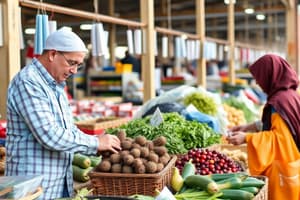Podcast
Questions and Answers
What is capital and provide two examples?
What is capital and provide two examples?
Capital is one of the factors of production that is produced and includes items such as machinery and buildings.
Explain the term 'ceteris paribus' and its significance in economics.
Explain the term 'ceteris paribus' and its significance in economics.
'Ceteris paribus' means 'other things being equal' and is used to isolate the effects of one variable by assuming other factors remain constant.
What role does choice play in the concept of scarcity?
What role does choice play in the concept of scarcity?
Choice is necessary when scarcity requires individuals to make decisions on how to allocate limited resources to meet their needs and wants.
Define competitive market equilibrium.
Define competitive market equilibrium.
What are complementary goods and how do they affect each other's demand?
What are complementary goods and how do they affect each other's demand?
What is the cost of production?
What is the cost of production?
What does a demand curve illustrate?
What does a demand curve illustrate?
How does entrepreneurship contribute to economic innovation?
How does entrepreneurship contribute to economic innovation?
What is equilibrium in a market context?
What is equilibrium in a market context?
Define equilibrium price and its significance.
Define equilibrium price and its significance.
Explain the concept of excess demand.
Explain the concept of excess demand.
What are factors of production, and why are they important?
What are factors of production, and why are they important?
Differentiate between 'how to produce' and 'for whom to produce' economic questions.
Differentiate between 'how to produce' and 'for whom to produce' economic questions.
What is the income effect in relation to consumer behavior?
What is the income effect in relation to consumer behavior?
Describe inferior goods and their relationship with income levels.
Describe inferior goods and their relationship with income levels.
What is meant by joint supply in economics?
What is meant by joint supply in economics?
Study Notes
Factors of Production
- Capital: Produced assets used in production, including machinery, tools, and buildings. Types include:
- Human Capital: Skills, knowledge, and health acquired by individuals.
- Natural Capital: Resources traditionally considered under 'land'.
- Financial Capital: Investments in financial instruments like stocks and bonds.
- Labor: Physical and mental efforts contributed by individuals in production.
- Land: Includes all natural resources, both agricultural and non-agricultural.
Economic Concepts
- Ceteris Paribus: Latin term meaning "other things being equal," assuming all other variables remain unchanged.
- Choice: Decision-making process in resource allocation due to scarcity.
- Economics: Study of resource allocation to satisfy unlimited human needs and wants.
Market Dynamics
- Competitive Market: Many buyers and sellers with no market power to influence prices.
- Demand: Consumer's willingness and ability to purchase goods at certain prices.
- Demand Curve: Illustrates the relationship between price and quantity demanded under ceteris paribus conditions.
- Disequilibrium: Occurs when quantity demanded does not equal quantity supplied, influenced by external factors.
Supply and Demand
- Excess Demand: Situation where demand exceeds supply, leading to shortages.
- Excess Supply: Occurs when supply surpasses demand, resulting in surpluses.
- Equilibrium: Balanced state where quantity demanded equals quantity supplied with no tendency for price change.
- Equilibrium Price: Market price where the quantity demanded equals quantity supplied.
- Equilibrium Quantity: The amount of goods bought and sold at equilibrium.
Production Decisions
- How to Produce: Choices on resource combinations and technologies for producing goods.
- For Whom to Produce: Decisions regarding income and wealth distribution among the population.
Consumer Behavior
- Income Effect: Describes how demand increases when real income rises due to falling prices.
- Inferior Goods: Goods for which demand decreases as consumer income increases.
- Complementary Goods: Products that are consumed together; a price increase in one leads to a decrease in demand for the other.
Entrepreneurship
- Special skill involving innovation, risk-taking, and opportunity-seeking for business development.
Production Relationships
- Joint Supply: Production of multiple goods derived from a single source, affecting their co-production.
Studying That Suits You
Use AI to generate personalized quizzes and flashcards to suit your learning preferences.
Description
Explore the key components of production, including capital, labor, and land, along with fundamental economic concepts such as ceteris paribus and market dynamics. This quiz will challenge your understanding of how resources are allocated and the choices made in economics. Test your knowledge on these essential topics in economic theory.




